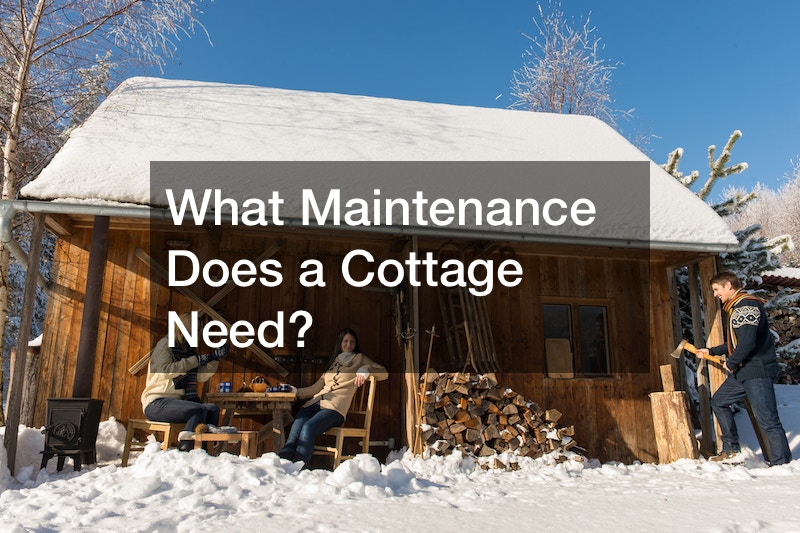
A cottage differs from other architectural styles of home in size and location. Typically, you find these smaller, one-story homes in rural areas, often by a lake, river, or at the beach. Because they’re built in a rural area, these small homes do have a few differences in care from a single-family home in a city.
Although the physical structure of a cottage does not differ from a full-sized house, it does use different utilities. For example, a cottage’s toilet typically flows into a septic tank instead of a waste sewage line. Factors such as this create differences in the maintenance required for a cottage. Read on to learn what upkeep a cottage needs.
Upgrading a Cottage

Some cottages undergo fabulous upkeep from the beginning. When you purchase a cottage, you may want to upgrade a few things, so let’s start here. Maybe you think a cottage needs more space. Most of these homes only feature one or two bedrooms and an equal number of bathrooms, so building an addition might top your project list. Start your expansion journey by hiring a general contractor.
Your general contractor helps you decide which addition option works best for your building site. Each lot consists of specific boundaries and measures a specific size. A lot comprises the smallest unit of measurement in a block and section of a subdivision or town. Each municipality or state sets rules about the percentage of a lot that the owner can use for building a home, so your general contractor will first help you find out if you already used the buildable area on your lot.
When building an addition, you have three options:
- Build upward
- Build downward
- Build outward
If you used the buildable area of the lot already, you will either need to build up or down. That means that you will turn your one-story cottage into a two-story or more cottage by either adding an upper floor or a lower level.
Cottages with an attic or a basement offer a simple solution. Renovate the attic or basement into a new bedroom and bathroom. Other cottages need the roof removed and a level built above the ground floor or the cottage lifted off its foundation and a level constructed beneath it. Both options cost more than building outward, but they preserve the cottage’s look and feel. Keep in mind that any addition will require additional contractors, such as a plumber for the plumbing installation in the bathroom and an electrician to wire the addition.
Repairing a Cottage

Perhaps your cottage offers you plenty of space, but it sat empty for some time. Sometimes, a cottage needs a little love and professional repairs. A quick survey of the property will reveal necessary repairs, such as a need for emergency roof repairs like a leak. Other issues may allow you a bit of time to address and improve the home.
If your roof looks good, but you want to improve the home, add gutter guards to the roofing gutters. If the cottage lacks roof gutters, add them as soon as possible to keep debris and leaves from clogging the gutters. Clean the roofing gutters thoroughly before installing the guards.
A slightly neglected cottage may also need its siding replaced. A local siding company can typically handle both the acquisition of materials and their installation. Inspect the exterior for siding tears and holes. Replace siding wherever it shows wear and tear because it protects the underlying wood sheathing of your home.
Renovating and Restoring a Cottage

In some cases, a cottage needs a full renovation before it proves comfortably habitable. The requirements might range from a bathroom renovation to drilling a well. What your cottage needs depends on your needs. We’ll leave the dark academia library to you and limit our discussion to bathrooms, kitchens, wells, etc.
Drilling a Well
A cottage needs a water source and in rural areas without a municipal water supply, this may require a well or a water tank. Choosing a well means hiring a well drilling service or local well driller to determine the proper location if any exists on your property. Not all land has access to the water table, so unless your lot sits above an underground aquifer, you may need to install water tanks.
Installing Water Tanks
Consider your water needs before purchasing a tank. If you currently reside in an area with municipal water, check your monthly bill to learn the amount of water in gallons that your household uses each month. Your tank should hold about that amount, otherwise, you will need to refill it constantly.
Water tanks come in an array of sizes. Smaller tanks, such as those holding fewer than 100 gallons work well for a weekend getaway cottage. Consider a 250 to 500-gallon tank if you plan to spend a week at a time at your cottage. In the U.S., the average person uses about 101 gallons of water per day, including toileting, bathing, washing dishes and clothes, cooking, and staying hydrated.
Installing a composting toilet or low-flow toilet and showerheads can reduce water consumption. When you must manually refill a tank, you become more cognizant of water use, so many people reduce the amount they use for washing dishes and clothes by combining loads and washing less frequently. If you want to reside full-time in your cottage, consider a 1,000-gallon water tank, so you can refill less frequently.
Maintaining the Water Supply
When you haul water from another source, whether a municipal well or a private one that charges a monthly or annual fee, the well owner must maintain the water supply, regularly testing the water, according to Environmental Protection Agency regulations. When you hire a company to drill a well on your land, you become the well owner and the water maintenance becomes your duty. When the well water tests reveal higher particulates than allowed by the EPA, you must treat the water to bring it within proper readings. Doing so benefits you because the EPA determines its regulations measurements based on human health and safety.
The EPA also prescribes methods of eliminating unwanted particulate matter in water. How to eliminate one substance may differ from how to eliminate another, so refer to EPA guidelines for the best results. Also, regularly inspect the well for cracks, leaks, etc. Ensure that no rodents can enter it.
General Considerations Applying to All Scenarios
Whether a cottage needs repairs, renovation, an addition, or you want to build one, a few things apply to every situation. Every domicile, regardless of size, needs plumbing in good working order. To keep up with your cottage’s needs, invest in plumbing services, including an emergency plumber, a well inspector and repair service doe well pump repairs, and drilling services, depending on your situation.
Perhaps your home does not feature siding. Some small houses consist of brick. Brick restoration involves a mason removing broken or cracked bricks and replacing them. In some cases, a cottage needs its brick sandblasted and resurfaced to look good again.
Older cottages built using traditional architecture may feature a fireplace and a fan system. In the 21st century, you might find it amenable to update the home to include a central heating, ventilation, and air conditioning (HVAC) system. Just like a standard-sized single-family home, a cottage needs annual HVAC maintenance to make sure it continues to operate appropriately.
Every cottage needs new flooring installed eventually. This typically requires a flooring expert or general contractor to remove the existing flooring and its underlayment, and then replace it with new flooring. Some flooring types require a specialist, such as hardwood flooring.
Weatherproofing

Some older cottages may lack waterproofing. In some cases, this only requires cleaning the siding, and then treating it with a water sealant. Most deck installers offer this service, so consider adding a deck to your cottage and having the installers water seal it and the cottage’s siding, too.
On the interior, a cottage needs caulking to waterproof it. Also, use weatherproofing materials to block drafts at the windows and doors. Waterproofing a cottage may require upgrading the roofing liner, too.
Adding storm-protective renovations like storm windows and storm doors can help protect any cottage or home from the elements. In areas where tornados occur annually, consider installing a storm shelter, either above ground or beneath the ground. You can have a contractor reinforce an existing basement to become a storm shelter.
Most rural homes use septic tanks instead of sewer lines that flow into a municipal sewer line. Septic tanks collect feces and urine for a year or two, then need pumping out by a septic tank cleaning service. As gross as this sewage cleanup sounds, without it, the sewage overtops the tank and backflows into the homeowner’s yard. Use a septic cleaning service about once per year to safely ensure problem-free plumbing.
Whether you do have rural water running into your cottage or you use a well or tanks, stock up on a few water quality products that a cottage needs. Consider adding a filtration system to your kitchen faucet that eliminates negative minerals and small particulates. Also, purchase a water testing kit, so you can check the water quality periodically. Do this every year and whenever you notice a visible change in the water, a change in its taste, or in how it smells.
Cottage Considerations
When working on a cottage or other home in a rural area, cut yourself a little slack. Finding contractors in a rural area differs from finding them in the city. You may need to hire services from a nearby-ish large city and pay a travel fee for having the work done.
While most articles on home upkeep offer projections of one to two weeks to find a contractor, in a rural area, it may take a month to six weeks to locate an available, licensed contractor. Expect to wait in line behind other homeowners who also need work done on their homes. The more rural the location, the tougher it will be to locate contractors.
Prioritize your work and have structural items completed first. Structural items refer to foundation issues, framing, roofing, and flooring. Completing these items first creates a safer cottage.
One advantage to a cottage comes from its smaller scale. If you dream of a high-end décor, doing so can be easier in a cottage. Its smaller scale makes it more affordable to purchase top-of-the-line materials. Small amounts of marble, quartz, or ceramic tile can go a long way. Consider satin or silk window treatments.
Adding a deck or patio can extend the yard’s usefulness. An outdoor living area offers a place to cook and eat outside. An outdoor kitchen design or outdoor living room can create a room to use during warm weather and adding a fireplace to it can extend its use to year-round.
Maintain a list of contractors you locate and sign up for their mailing list, if they offer them. This lets you keep in touch with each contractor to learn when they offer specials and to get ideas for future projects. Making friends with local contractors can help you get quick help when an emergency occurs.
Getting Started on Your Cottage Project
Building a cottage using a modular concept proves easiest. Build 4′ x 8′ sections of framing off-site and haul them to the building site. Many contractors will agree to this method and not charge extra for it.
Renovating or repairing a cottage takes a bit longer in a rural area. You may need roofing, flooring, or siding repair work. Have the septic tank cleaned annually and maintain it. Choose a water supply method – a private well, shared well, or water tank system.
Updating a rural cottage takes more time than a large house in the city because of a shortage of contractors. Research local and nearby contractors, and prepare to wait in line for your turn. Rural contractors stay busy but inherently do a good job because they depend on referrals more so than city contractors.



